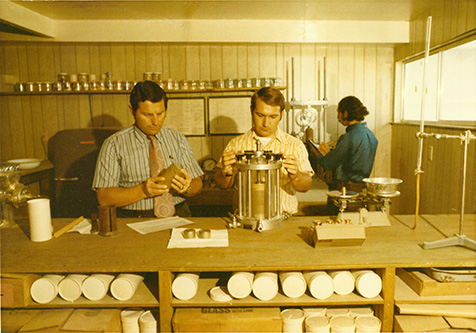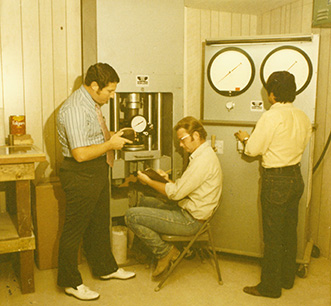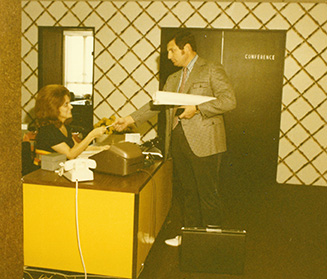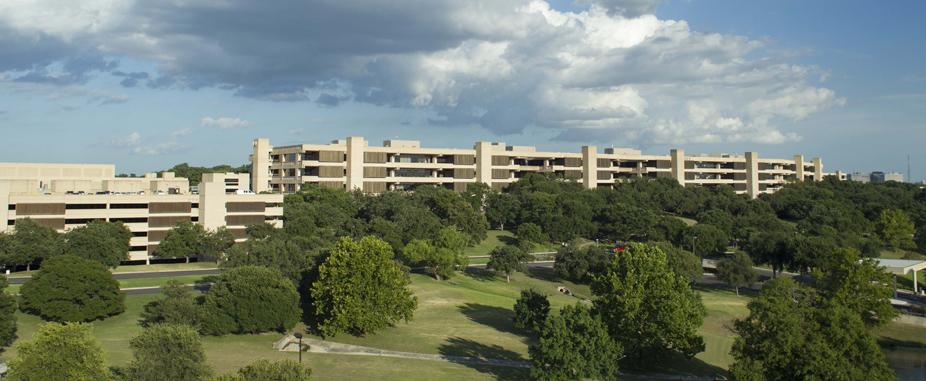
Photo: Dr. Carl Raba, PE, (above left) checks samples with two lab technicians in the early days of Raba & Associates.
By 1968, when Bunny Jean and Carl Raba decided to go into business for themselves, Carl had earned his Ph.D. in Civil Engineering from Texas A&M and had experience in his field, gained from working for other firms. The two young entrepreneurs, with 5 kids in tow, decided to go for it and open their own geotechnical firm.
The first company that gave the fledgling engineering firm, known as Raba & Associates, a project was Feigenspan & Pinnell, a local, major structural engineering firm. “They took a chance on us and gave us a large elementary school in North East ISD on which we provided the geotechnical investigations,” said Carl Raba, PhD, PE, currently Chairman Emeritus of Raba Kistner and serving on the Board of Directors.
Soon after, architects recognized that the firm could handle significant challenges and they began to give them projects, also. Peter Callins, Architect, and O'Neill Ford, Architect (who had already made a name for his company, known as Ford, Powell, Carson) gave the firm major projects, including the new UTSA campus development, (to be covered in detail in another installment of this article series) as well as other significant projects, such as manufacturing and development work. As a result, the firm began to experience exponential growth.
Several years later, Dr. Raba found out about the future development of the USAA campus, perhaps the largest project ever to be built in San Antonio. Others in the industry were not aware of the planned project.

According to Dr. Raba, “I went out of my way to meet the architectural firm—HKS from St. Louis—that USAA had selected to design the significant project. HKS is now a world wide firm but it was quite large, even at that time. USAA used them for everything. I pitched just geotechnical services to HKS initially,” he said.
Coincidentally, Project Control was the project manager of the effort.
“The project was incredibly large, so I gave them my ideas on what the significant challenges were going to be,” explained Carl. There were several unique features, one of which was a very deep excavation to accommodate multi sub levels, cut into the side of a hill. That meant earth pressure loads were going to be tremendously high against the sub level walls.
“We proposed using lifts of cement-stabilized soil as backfill to reduce lateral pressures,” said Carl. Once he got the go-ahead, the lifts were constructed in a series of steps, allowing each lift to cure between installations. In doing that, each lift resulted in no additional lateral earth pressures on the structural walls that extended along a significant part of the project (see photo above). “In today’s dollars, we saved USAA millions on the job.”
Once the geotechnical work was in progress, Carl decided to ask the architectural and structural firms if Raba & Associates could do the construction materials testing (CMT).
“They trusted us enough to say ‘yes’, even though we had not performed CMT previously, and so we set up our lab in some old horse stables that were on the property,” explained Carl. “That proximity to the project meant we gave them fast turn around and we literally responded 24/7 to their needs.” The volume of just concrete placed on the job—drilled piers, walls, slabs and columns, plus the structural steel testing—was unbelievable, which allowed the firm to buy all of the equipment they needed to go into the construction materials testing business.
This is the time when Bunny Jean talked Carl into hiring Dick Kistner, PE, a well known, local construction materials engineer. (This interesting story will be featured in a future article).
“I came to Raba & Associates in March, 1974,” said Dick Kistner, PE. “We had two large projects underway—USAA and one other—and some smaller work. I was fortunate to be able to work on the USAA project during various states of building the campus. The project was well placed to have a field office at the campus, out of which our techs worked and went directly to the project each day.”
USAA had a full time, on-site geologist and tech reviewing the excavated soils to evaluate the presence of highly plastic clay soils below the parking garage and other structures. “In addition, the daily concrete placements had two full-time, on-site techs sampling concrete being delivered to the project at several different locations every working day, starting before sunrise and lasting until about 4:00 pm. It was a tremendous project and an exciting time,” said Dick.
Photo: USAA campus, as it appears today.
“The USAA project, and Dick Kistner’s guidance, grew the materials testing part of our business quickly; however, it was the higher level of technology that we used in our lab that differentiated us from other, local firms. We offered a level of engineering that was only available in Dallas or Houston at that time,” finished Carl.
This article is the third in a series of articles about the history of Raba Kistner. Click here to watch Dr. Raba reflect on key moments in our firm's history.














